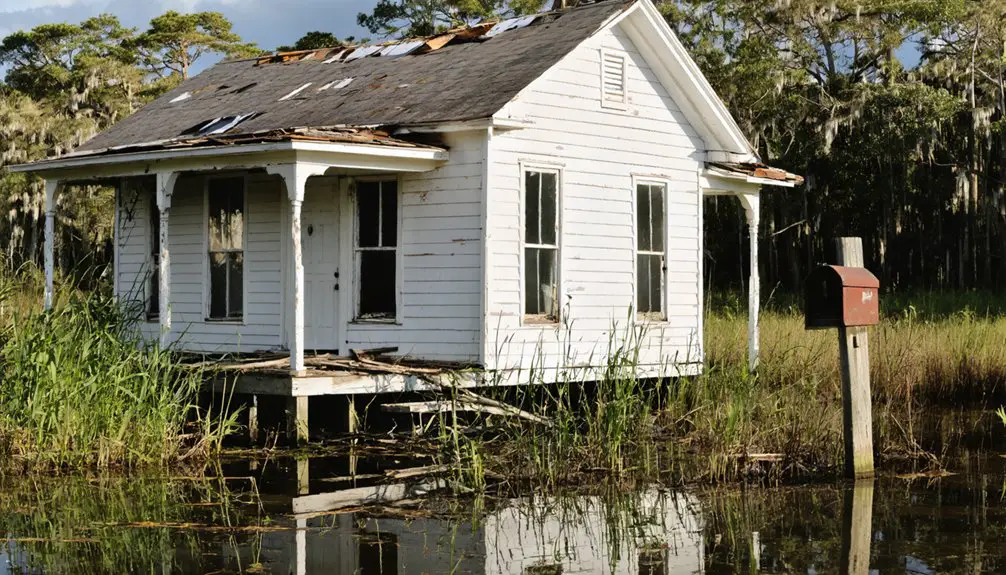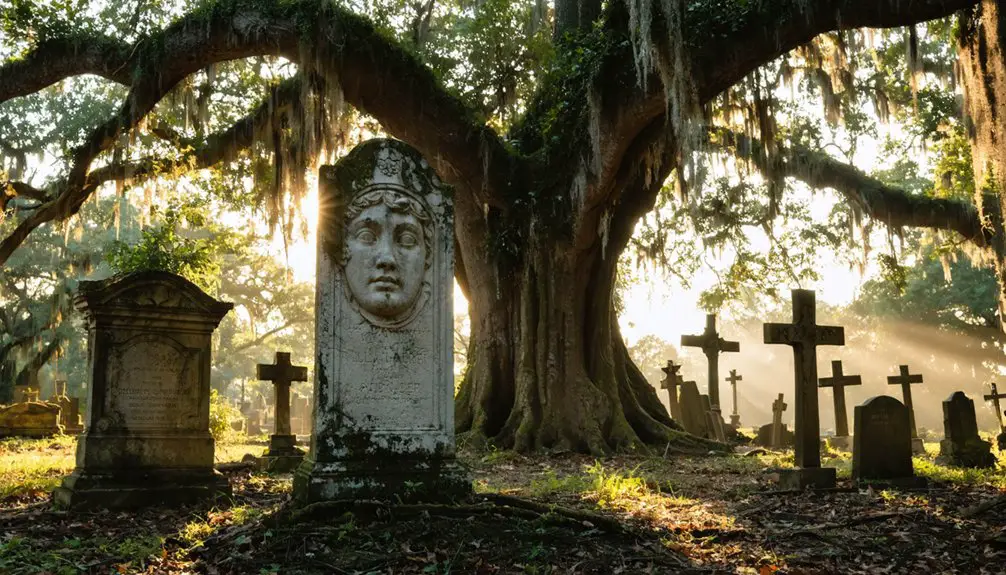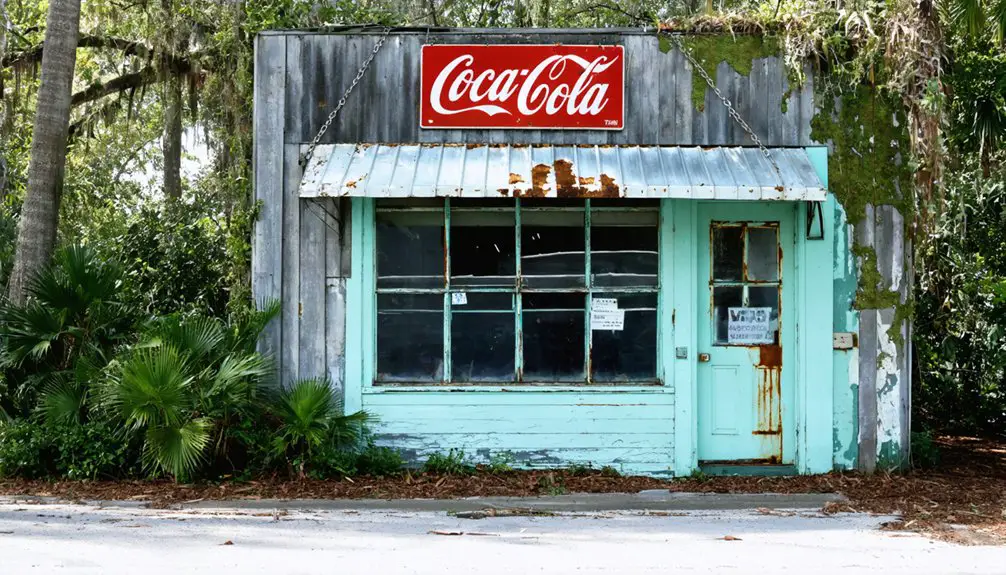You’ll find Spray, Florida’s remains in a quiet corner of the state, where it briefly flourished as a timber town from 1910 to 1922. The settlement relied on specialized tramway railroads and an innovative float pond system to harvest cypress trees, employing workers at about 14 cents per hour. After just 12 years, the depletion of local cypress trees led to its abandonment, though its cemetery still stands as a silent memorial to this fascinating chapter of Florida’s industrial past.
Key Takeaways
- Spray was established in 1910 as a lumber town focused on cypress tree harvesting and sawmill operations in Florida.
- The town operated for only 12 years before being abandoned due to the complete depletion of local cypress resources.
- Specialized tramway railroads and float pond systems were essential infrastructure for Spray’s logging and timber processing operations.
- A devastating sawmill fire in 1898 severely impacted the local logging industry, contributing to the town’s eventual decline.
- Today, only the cemetery remains as a historical marker of Spray’s existence, featuring weathered headstones of early settlers.
A Small Town’s Humble Beginnings
While many Florida ghost towns faded into obscurity gradually, Centralia’s story began in 1910 with a singular purpose: harvesting the ancient cypress trees that dominated the surrounding swamps. The town’s origins were deeply rooted in the timber industry, with its economic foundations built entirely around a bustling sawmill operation.
You’ll find that Centralia’s early development was precisely engineered for maximum timber extraction. The town’s builders constructed specialized tramway railroads that penetrated deep into the swamplands, allowing workers to transport massive cypress logs to the mill.
At the mill site, you’d have seen an elaborate float pond system where the logs were sorted and processed before being transformed into finished lumber. From there, the processed timber made its way across Florida and beyond via rail networks. The operation lasted only twelve years before the depletion of cypress trees led to the town’s abandonment.
The Railroad’s Vital Role
Railroads transformed Centralia’s timber operations into a thriving enterprise by connecting the isolated town to Florida’s broader transportation network.
You’d find the Florida Railroad’s east-to-west route particularly essential, as it slashed shipping distances by 800 miles while bypassing treacherous reefs in the Straits of Florida.
Construction of the Florida Central Railroad began in 1855, marking the start of significant railway development in the region.
The South Florida Railroad began serving Orlando and Sanford in 1880, further expanding transportation options in Central Florida.
The railroad infrastructure near Spray played a significant role in regional connectivity, with lines like the 33.5-mile Brooksville and Hudson Railroad supporting local logging operations.
You could’ve witnessed how these rail connections dramatically lowered transportation costs and opened new markets for timber exports.
While natural disasters and the Great Depression eventually challenged the railroads’ dominance, their impact on Spray’s development was undeniable, creating both direct employment and spurring industrial growth throughout Pasco County.
Industry and Commerce in Early Spray
You’ll find that Spray’s early commercial growth centered around the railroad’s arrival, which enabled efficient transport of goods and resources from the area.
Like the early settlers who built successful farming communities in South Dade, Spray’s residents adapted to utilize local resources for economic development.
The town’s sawmill operations provided significant local employment while processing timber from the surrounding pine forests. The expansion of railroads throughout Florida during this period helped connect rural timber towns like Spray to larger markets.
The extraction of pine resin for turpentine production emerged as another essential industry, following common practices throughout Florida’s naval stores sector.
Railroads Drive Local Growth
As Florida’s East Coast Railway expanded southward in the 1890s, the small town of Spray experienced unprecedented commercial growth that transformed its economy.
You’d find that railroad benefits extended far beyond just moving goods – they revolutionized local industry by connecting Spray to major markets along Florida’s east coast.
The transportation efficiency brought by rail lines meant you could now ship agricultural products, especially citrus, more safely and quickly than the risky maritime routes through the Straits of Florida.
Mule-drawn carts were quickly phased out as steam-powered trains became the primary mode of transportation for the region’s goods.
You’d see manufactured goods and farming equipment arriving regularly, helping modernize local businesses.
The railroad’s presence attracted new industries beyond timber, diversifying Spray’s economy into agriculture and trade while fostering connections with coastal ports that enhanced export opportunities.
Standard Oil wealth funded much of the railroad expansion that connected towns like Spray to the wider region, thanks to Henry Flagler’s earlier business success.
Sawmill Operations and Employment
The bustling sawmill industry formed the backbone of Spray’s early economic development, operating alongside the expanding railway network. By the 1880s, 135 sawmills were operating throughout Florida, reflecting the industry’s rapid growth.
You’d find a mix of skilled workers operating steam-powered equipment, from experienced sawyers to mule drivers. Sawmill techniques evolved from simple water-powered vertical saws to more efficient steam-driven operations, revolutionizing timber processing in the region. Workers earned approximately 13.67 cents per hour in sawmill jobs, significantly less than their northern counterparts.
Labor conditions were significantly harsh, with workers facing:
- Long hours and low wages with minimal chances for advancement
- High risk of injury from dangerous machinery
- Unstable employment, especially during economic downturns
- Failed attempts at organizing strikes for better working conditions
The mills relied heavily on steam-powered skidders to harvest timber from swampy areas, while tram roads and log carts transported lumber to processing facilities, creating a complex network of industrial activity.
Turpentine Production Practices
While sawmills dominated Spray’s early economy, turpentine production emerged as another essential industry between the late 1800s and 1920s, capitalizing on the region’s abundant longleaf pine forests.
The turpentine extraction techniques involved workers cutting distinctive chevron-shaped gashes, known as “catfaces,” into the pine trees. They’d insert metal gutter-aprons into these cuts to channel the oozing resin into collection cups.
You’d find workers tapping these trees repeatedly throughout the season, from early spring to October, making fresh cuts above dried sap areas to maintain the flow.
After collection, they’d process the raw resin through distillation – a 50-gallon batch typically yielding 325 pounds of pitch and 10 gallons of turpentine.
The introduction of the Herty Cup in 1903 improved resin collection methods by reducing damage to the trees.
Natural Disasters and Economic Downfall

During the late 19th century, Spray, Florida experienced a devastating series of natural disasters and economic setbacks that ultimately led to its downfall.
You’ll find that the town’s economic resilience was severely tested when the local sawmill burned down in 1898, crippling the logging industry. The community’s adaptation efforts were further hampered by recurring floods that damaged properties and farmlands.
The devastating sawmill fire of 1898 marked the beginning of Spray’s decline, as floods continually thwarted recovery attempts.
- The sawmill fire destroyed the town’s primary industrial facility
- Frequent flooding caused extensive damage to agricultural lands
- Citrus groves suffered from diseases and environmental disruptions
- Limited railroad infrastructure restricted trade opportunities
These challenges, combined with soil degradation and resource depletion, forced many residents to abandon their homes.
The Great Depression dealt the final blow to this struggling community, leading to Spray’s eventual classification as a ghost town by mid-20th century.
Life During the Great Depression Era
As Florida’s economic troubles deepened following the 1929 stock market crash, Spray’s residents faced unprecedented hardships that would reshape their community forever.
You’d find families struggling to maintain their livelihood as bank failures wiped out savings and unemployment soared. The economic hardship touched nearly every aspect of daily life, with roughly 90,000 Florida families directly impacted by the early 1930s.
Despite these challenges, community resilience emerged through trusted local institutions. You’d see neighbors supporting one another as about one-fourth of Floridians ultimately relied on federal relief programs.
The Mediterranean fruit fly crisis devastated local citrus production, dealing another blow to agricultural workers. Relief finally arrived during World War II, when military base construction and war-related industries created new employment opportunities, forever changing Spray’s economic landscape.
Cemetery: The Last Standing Witness

As you walk among the weathered headstones of Spray Cemetery, you’ll find yourself reading the stories of early settlers etched in granite and marble, each marker a tribute to the town’s vibrant past.
The cemetery’s family plots reveal intricate connections between Spray’s pioneering households, with generations of shared surnames illustrating the close-knit nature of this former Florida community.
Thanks to dedicated volunteers and descendants who maintain the grounds, this historic burial ground continues to serve as the most tangible link to Spray’s heritage, preserving both local history and cherished family memories.
Graves Tell Local Stories
The aging cemetery of Spray stands as a silent chronicler of the ghost town’s past, where weathered headstones tell stories that buildings and streets no longer can.
Through grave inscriptions dating back to the 1800s, you’ll discover the historical significance of families who shaped this forgotten community. Each stone reveals intimate details of life and death in early Florida, from infant mortality rates to family connections that once defined Spray’s social fabric.
- Names etched in stone trace migration patterns and demographic shifts throughout the town’s existence
- Epitaphs provide clues about causes of death and family relationships
- Child graves reflect the harsh realities of frontier healthcare
- Burial customs and marker styles indicate social status and cultural practices
Historical Family Connections
Standing sentinel over generations of family histories, Spray’s cemetery serves as the most enduring link to the town’s pioneering families.
You’ll discover family lineage carved in stone, where birth dates, death records, and family names reveal the intricate web of relationships that once defined this community. Through maintained gravesites, you can trace genealogical connections back to the earliest settlers, uncovering stories of triumph and tragedy.
Today’s descendants actively preserve this essential historical archive, clearing overgrowth and protecting headstones from deterioration. Their efforts keep family histories alive, even as the town itself has vanished.
The cemetery remains a sacred space where you can connect with the past, understanding how disease, hardship, and determination shaped these pioneer families who built Spray from untamed Florida wilderness.
Preservation Through Community Care
While Spray’s cemetery stands as the last physical remnant of this vanished town, its preservation relies on dedicated community stewardship.
You’ll find that successful preservation efforts require organized community engagement through established hierarchies and defined roles. The cemetery serves as an outdoor museum, documenting cultural traditions and genealogical histories that might otherwise be lost.
- Local community members perform essential cleaning and basic maintenance to prevent marker decay
- Public awareness campaigns, including tours and newsletters, strengthen preservation participation
- Partnerships between churches, universities, and civil rights groups amplify restoration resources
- Documentation through photographs, mapping, and surveys guides long-term preservation planning
Your involvement in protecting this historic site helps maintain ancestral legacies while ensuring future generations can connect with their community’s past.
Archaeological Discoveries and Artifacts

Archaeological surveys in Spray’s riverbeds have yielded a wealth of historical artifacts that illuminate daily life in this former mining community.
You’ll find evidence of both industrial and personal life through metal detecting and specialized archaeological techniques. The riverbed searches have uncovered cork-top medicine flasks, whiskey jugs, and soda bottles, while side-scan sonar reveals larger submerged objects.
Working alongside State and Tribal Historic Preservation Officers, researchers have documented settlement patterns through artifact scatters near spring-fed water sources.
The artifact significance extends to early settler homesteads, including possible Disney family ancestral properties. Mining tools, workers’ personal items, and industrial remnants tell the story of Spray’s rise and decline, preserved beneath layers of sediment and time.
Exploring Spray’s Hidden Pathways
Hidden beneath Florida’s dense wilderness, Spray’s network of historic pathways reveals the ghostly remnants of this once-thriving community.
You’ll discover these hidden trails weaving through hardwood forests and swamps, leading to the serene Suwanacoochee Spring and abandoned industrial structures. Natural exploration along these routes offers glimpses into Florida’s untamed beauty and rich history.
- Follow the 2.2-mile Earthworks Trail across an old bridge to reach the spring’s crystal-clear waters
- Navigate the River Path, guided by the sound of rushing water to where two rivers meet
- Explore remnants of mule barns, pump houses, and old ferry landings along overgrown pathways
- Visit secluded spots like Falmouth Spring, where you can observe quiet waters amid dense forest canopy
Legacy of a Lost Community
Through decades of abandonment, Spray’s compelling story endures as a tribute to the rise and fall of early Florida settlements.
You’ll find evidence of community resilience in the town’s cemetery, where headstones and burial records tell stories of the families who once called this place home. The town’s decline, triggered by the devastating 1898 sawmill fire and recurring floods, reflects broader patterns of economic vulnerability in rural Florida communities.
Today, cultural remembrance lives on through guided tours, historical documentation, and outdoor exploration.
Exploring abandoned settlements through guided walks and preserved records keeps Florida’s forgotten stories alive for future generations.
You can trace Spray’s legacy in the preserved natural areas and partially visible structural remnants. The town’s story resonates as part of Florida’s broader historical narrative, reminding you how transportation, agriculture, and industry shaped the destiny of early settlements.
Frequently Asked Questions
Are There Any Reported Ghost Sightings or Paranormal Activities in Spray?
You won’t find documented ghost encounters or paranormal investigations in Spray’s records. Unlike other Florida ghost towns, there’s no evidence of supernatural activity or official research into unexplained phenomena here.
What Happened to the Residents Who Left Spray?
Like scattered seeds in the wind, you’ll find Spray’s people moved to nearby towns, leaving abandoned homes behind. They found work in logging, mining, and urban industries, adapting to survive.
Can Visitors Legally Explore the Ghost Town Site Today?
You’ll need to verify legal access before exploring, as land ownership isn’t clearly documented. Follow visitor guidelines by checking with county offices and obtaining necessary permissions to avoid trespassing issues.
Were There Any Notable Crimes or Mysteries Associated With Spray?
You won’t find any documented unsolved disappearances or criminal records specifically tied to Spray. Historical records suggest the town’s decline was purely economic rather than linked to any notable mysteries.
Did Any Famous Historical Figures Ever Visit or Live in Spray?
Have you ever wondered about famous visitors to this forgotten place? Despite extensive research, there’s no evidence of any historically significant figures ever living in or visiting Spray.
References
- https://www.youtube.com/watch?v=0kzAaaal1X0
- https://www.youtube.com/watch?v=8QapC-yk4Bo
- https://www.youtube.com/watch?v=bx7eU14uI24
- https://www.tiktok.com/@socialshepherdadventures/video/7342301852702100778
- https://en.wikipedia.org/wiki/List_of_ghost_towns_in_Florida
- https://dirtmedic.wordpress.com/2013/08/27/centralia-ghost-town-florida/comment-page-1/
- https://www.youtube.com/watch?v=3mDsPKA4B2o
- https://en.wikipedia.org/wiki/Florida_Railroad
- https://en.wikipedia.org/wiki/South_Florida_Railroad
- https://www.fivay.org/railroads.html



